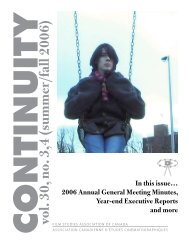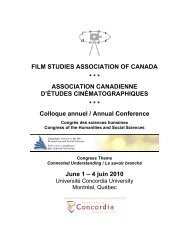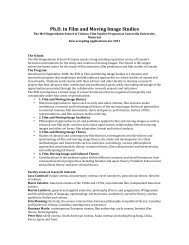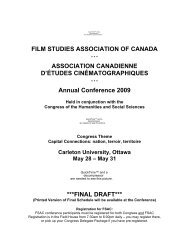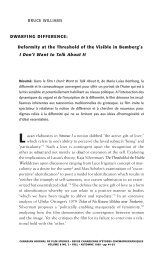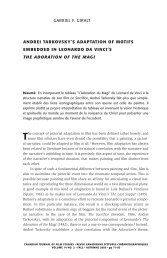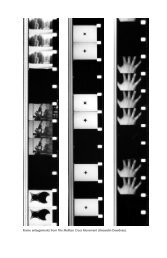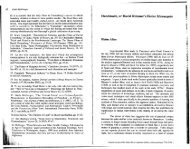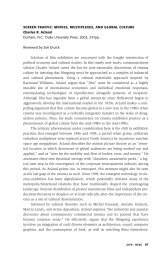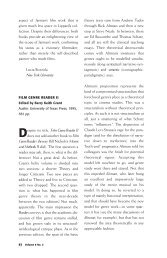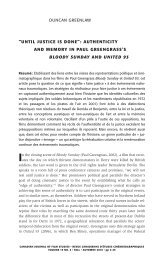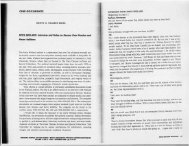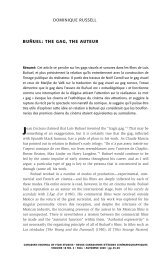cinematic experience, film space, and the child's world - Film Studies
cinematic experience, film space, and the child's world - Film Studies
cinematic experience, film space, and the child's world - Film Studies
Create successful ePaper yourself
Turn your PDF publications into a flip-book with our unique Google optimized e-Paper software.
005.Kuhn.19.2:005.Kuhn. 11/18/10 5:32 PM Page 93<br />
Fig. 12-13. Ratcatcher<br />
(Lynne Ramsay, 1999)<br />
from internal reality to outside <strong>world</strong>; from internal…to observational.” 25<br />
This play of fantasy <strong>and</strong> a brutal reality intertwines with, <strong>and</strong> spins off, <strong>the</strong><br />
<strong>film</strong>’s plot in a deceptively casual manner. So, for example, as well as providing<br />
a mise en scène of urban poverty, deprivation <strong>and</strong> squalor, <strong>the</strong> bags of rotting<br />
rubbish that litter <strong>the</strong> <strong>film</strong>’s <strong>space</strong>s accentuate its <strong>the</strong>mes of waste, vermin, pets<br />
<strong>and</strong> children’s play. Perhaps <strong>the</strong> closest <strong>the</strong> <strong>film</strong> comes to social realism is a plotline<br />
about James’s family’s desperate desire to move out of <strong>the</strong>ir tenement flat<br />
<strong>and</strong> into a new house. But even here, <strong>the</strong> very topos of “home” is shot through<br />
with imagination <strong>and</strong> fantasy. The <strong>film</strong>’s organization of <strong>space</strong>s <strong>and</strong> movement<br />
suggests that <strong>the</strong> quests facing James are indeed about separation/individuation,<br />
<strong>and</strong> that, in <strong>the</strong> end, <strong>the</strong>se come back to issues of home <strong>and</strong> its thresholds, <strong>and</strong><br />
<strong>the</strong> relationship between <strong>the</strong>se <strong>and</strong> a series of non-home <strong>space</strong>s that are in varying<br />
degrees “friendly,” challenging or dangerous. The <strong>film</strong> lays out, <strong>and</strong> moves<br />
through <strong>and</strong> between, its <strong>space</strong>s in a manner that echoes <strong>the</strong> liminality <strong>and</strong> kinesis<br />
of transitional phenomena.<br />
Therefore, although Ratcatcher may certainly be read in <strong>the</strong> conventional<br />
manner in terms of plot <strong>and</strong> character, to do no more than this misses entirely<br />
its intensity as <strong>cinematic</strong> <strong>experience</strong>. If Ratcatcher is indeed “about” childhood,<br />
or childhood trauma, or growing up rough in Glasgow, <strong>the</strong>se <strong>the</strong>mes are written<br />
into <strong>the</strong> <strong>film</strong>’s very matters of expression, <strong>the</strong> very inner <strong>and</strong> outer <strong>space</strong>s <strong>and</strong><br />
psychical processes that have to be negotiated in <strong>the</strong> child’s, James’s, <strong>world</strong>. This<br />
argument may be tested by briefly examining <strong>the</strong> <strong>space</strong>s within <strong>the</strong> <strong>film</strong>, <strong>the</strong>ir<br />
defining characteristics <strong>and</strong> how <strong>the</strong>y interconnect. 26<br />
CINEMATIC EXPERIENCE, FILM SPACE, AND THE CHILD’S WORLD 93



